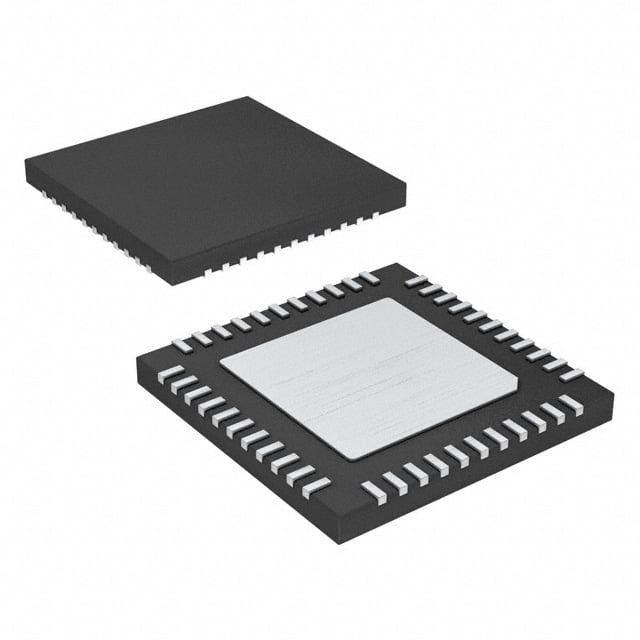Consulte las especificaciones para obtener detalles del producto.

PIC16F77-E/ML
Product Overview
Category
The PIC16F77-E/ML belongs to the category of microcontrollers.
Use
This microcontroller is commonly used in various electronic applications that require embedded control and processing capabilities.
Characteristics
- High-performance 8-bit RISC architecture
- Flash-based program memory
- Wide operating voltage range
- Low power consumption
- Enhanced peripheral integration
- Flexible I/O options
Package
The PIC16F77-E/ML is available in a small form factor package, known as a micro lead frame (ML) package. This package offers compactness and durability, making it suitable for space-constrained applications.
Essence
The essence of the PIC16F77-E/ML lies in its ability to provide efficient and reliable control and processing capabilities within a compact and low-power package.
Packaging/Quantity
The PIC16F77-E/ML is typically packaged in reels or tubes, with a quantity of 1000 units per package.
Specifications
- Microcontroller Family: PIC16F
- CPU Speed: Up to 20 MHz
- Program Memory Size: 8 KB
- RAM Size: 368 bytes
- Number of I/O Pins: 33
- ADC Channels: 8
- Timers: 3
- Communication Interfaces: USART, SPI, I2C
- Operating Voltage Range: 2.0V to 5.5V
- Operating Temperature Range: -40°C to +125°C
Detailed Pin Configuration
The PIC16F77-E/ML features a total of 40 pins, each serving a specific purpose. The pin configuration is as follows:
- VDD - Power supply voltage
- RA0 - General-purpose I/O pin
- RA1 - General-purpose I/O pin
- RA2 - General-purpose I/O pin
- RA3 - General-purpose I/O pin
- RA4 - General-purpose I/O pin
- RA5 - General-purpose I/O pin
- MCLR - Master Clear input
- VSS - Ground
- RB0 - General-purpose I/O pin
- RB1 - General-purpose I/O pin
- RB2 - General-purpose I/O pin
- RB3 - General-purpose I/O pin
- RB4 - General-purpose I/O pin
- RB5 - General-purpose I/O pin
- RB6 - General-purpose I/O pin
- RB7 - General-purpose I/O pin
- VDD - Power supply voltage
- OSC1 - Oscillator input
- OSC2 - Oscillator output
- RC0 - General-purpose I/O pin
- RC1 - General-purpose I/O pin
- RC2 - General-purpose I/O pin
- RC3 - General-purpose I/O pin
- RC4 - General-purpose I/O pin
- RC5 - General-purpose I/O pin
- RC6 - General-purpose I/O pin
- RC7 - General-purpose I/O pin
- VSS - Ground
- RD0 - General-purpose I/O pin
- RD1 - General-purpose I/O pin
- RD2 - General-purpose I/O pin
- RD3 - General-purpose I/O pin
- RD4 - General-purpose I/O pin
- RD5 - General-purpose I/O pin
- RD6 - General-purpose I/O pin
- RD7 - General-purpose I/O pin
- VSS - Ground
- VDD - Power supply voltage
- RB3/PGM - Programming mode selection
Functional Features
The PIC16F77-E/ML offers a range of functional features, including:
- High-performance CPU with efficient instruction set
- Flash program memory for easy reprogramming
- Enhanced I/O capabilities for versatile interfacing options
- Analog-to-Digital Converter (ADC) for precise analog measurements
- Timers and counters for accurate timing control
- Communication interfaces (USART, SPI, I2C) for data exchange
- Interrupt handling for real-time event-driven applications
Advantages and Disadvantages
Advantages
- Compact size and low power consumption make it suitable for portable devices
- Wide operating voltage range allows for flexibility in power supply selection
- Enhanced peripheral integration reduces the need for external components
- Flash-based program memory enables easy firmware updates
- Versatile I/O options facilitate seamless interfacing with other devices
Disadvantages
- Limited program memory size may restrict the complexity of applications
- Relatively low RAM capacity may limit the amount of data that can be processed simultaneously
- Lack of advanced features found in higher-end microcontrollers
Working Principles
The PIC16F77-E/ML operates based
Enumere 10 preguntas y respuestas comunes relacionadas con la aplicación de PIC16F77-E/ML en soluciones técnicas
What is the maximum operating frequency of PIC16F77-E/ML?
- The maximum operating frequency of PIC16F77-E/ML is 20 MHz.Can PIC16F77-E/ML be used for analog signal processing?
- Yes, PIC16F77-E/ML has built-in analog-to-digital converters and can be used for analog signal processing.What are the available communication interfaces on PIC16F77-E/ML?
- PIC16F77-E/ML supports USART, SPI, and I2C communication interfaces.Is it possible to program PIC16F77-E/ML in C language?
- Yes, PIC16F77-E/ML can be programmed using C language with appropriate compilers and development tools.What are the available memory options for program storage in PIC16F77-E/ML?
- PIC16F77-E/ML has 8 KB of flash program memory for code storage.Can PIC16F77-E/ML be used in battery-powered applications?
- Yes, PIC16F77-E/ML is suitable for battery-powered applications due to its low power consumption features.Does PIC16F77-E/ML have built-in timers and counters?
- Yes, PIC16F77-E/ML has multiple built-in timers and counters for various timing and control applications.What are the available development tools for programming PIC16F77-E/ML?
- Development tools such as MPLAB X IDE and PICkit programmers can be used for programming PIC16F77-E/ML.Can PIC16F77-E/ML be used in industrial automation applications?
- Yes, PIC16F77-E/ML is suitable for industrial automation applications due to its robust features and communication capabilities.Are there any temperature limitations for operating PIC16F77-E/ML?
- PIC16F77-E/ML can operate within a temperature range of -40°C to 125°C, making it suitable for a wide range of environments.

